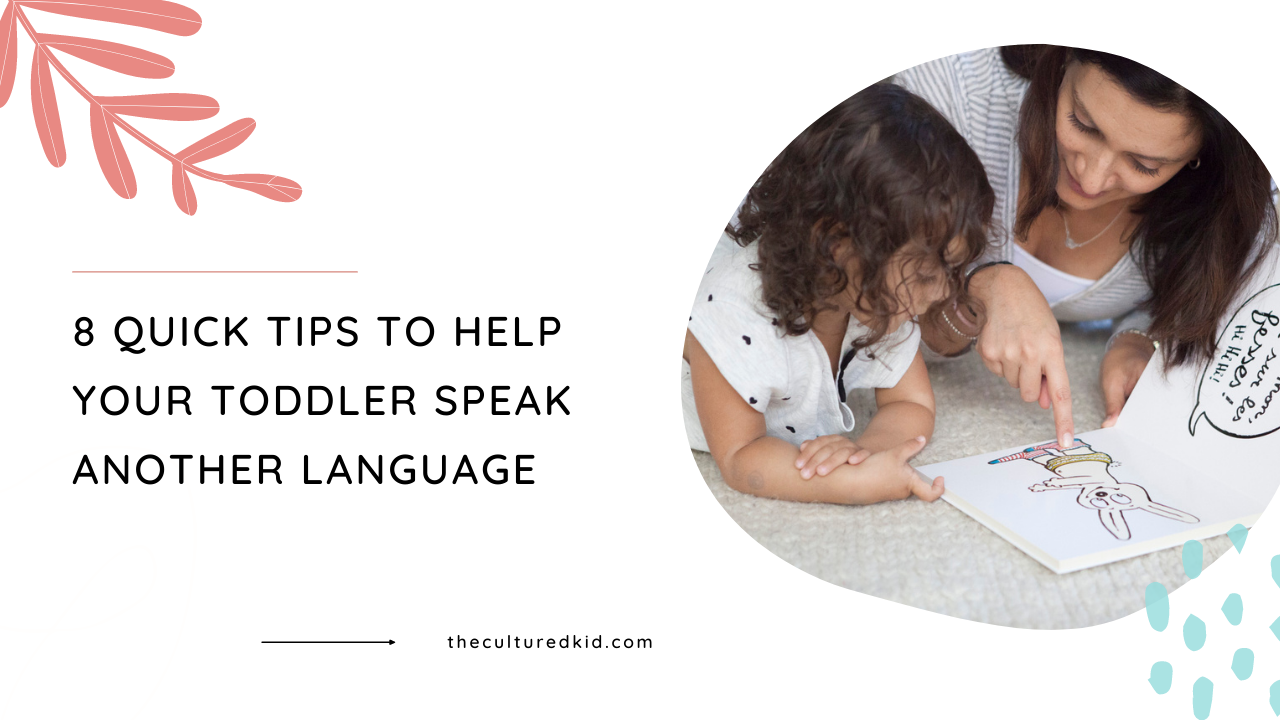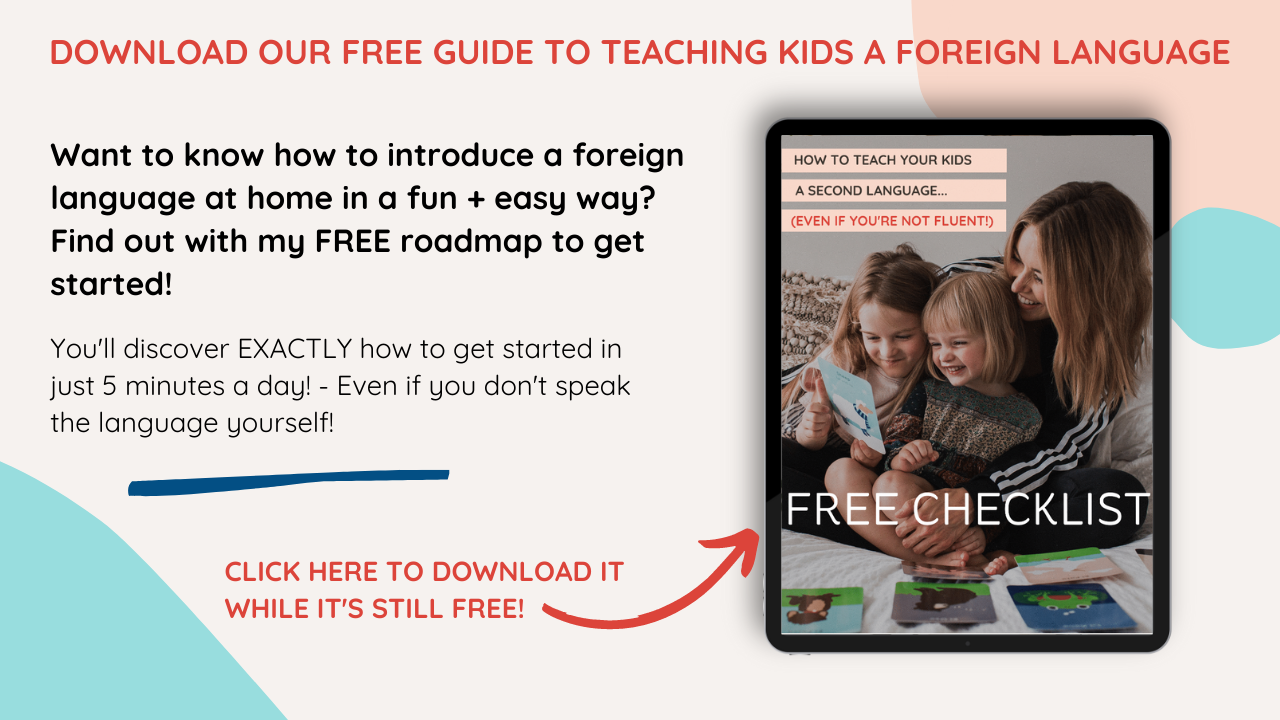8 Quick Tips To Help Your Toddler Speak Another Language

Toddler-hood has arrived and your super keen for your little one to start talking!
In English and in French. Or whatever language you’ve got your bilingual heart set on.
Hearing those first words will make your heart bubble up with joy and you think you’ll **never get tired of hearing them say “Mama, Mama!”
(**ahhhhh.... how quickly that could change)
Of course, in the absence of real problems, your little one is going to learn to talk eventually but there are lots of ways you can encourage their bilingual language development day by day.
And nope, you won’t mess with your toddlers head by introducing a second language while they’re still learning English! This is actually the BEST time to do it.
I’ve put together these 8 quick tips I hope you find helpful to encourage your toddler to speak another language or if you need some practical tips you can download my starter guide.
When does the talking action begin
Here’s a general(ish) timeline on when the talking action begins with your toddler.
- From 24-30 months - speak in correct sentences
- From 26-36 months - be understood more by strangers
- from 26-36 months use pronouns (I, you, me, we, they) and some plurals
- By about 3 years old - Understand most of what adults say
Of course, every kiddo develops their communication skills at a different pace, some may talk sooner or later, so don’t get too hung up on exact time frames!
- Start with a song!
Toddlers love singing and music - they actually learn to sing before they learn to talk! Music is an awesome way to introduce new words in another language
Don’t just have the song playing in the background - get involved! If you sing along, you’ll help them learn quicker.
- Use fun actions to introduce new words
Teaming actions with words will help your little one understand the new vocab you’re introducing. Exaggerate your facial expressions and make expressive gestures to emphasise the word.
Tasting ice cream? Lick your lips in an over the top kind of way (yep, this is your chance to get a little ridiculous) and repeat the word ice-cream in the new language.
Jump up and down, skip, clap, and hop all while using the forgein word to describe what you’re doing!
Jump!
Saltare (Italian)
Clap!
Applaudire (Italian)
Your toddler is more likely to remember new words and their meaning when teamed with a fun action.
- Double up
Let’s say it’s bath time and your toddler’s favourite bath toy is a green frog.
Pick up the frog and in English say “Frog! Can you say frog?”
Wait to see if your toddler responds. Then repeat in the second language you’re teaching them
Frog!
Rana! (Spanish)
Stick with 1 toy or object repeating it over and over in both English and the second language. You could choose to focus on one word for each bath time / dinner time etc.
- Elaborate on their speaking attempts
You can elaborate on your child's speaking attempts in both English and the second language.
For example, if he says “truck” you can say “Yes, that’s your big, yellow truck!” and then repeat the phrase again Spanish / French / Italian...whatever amazing language you’re introducing them to!
- Describe what you’re doing (and get used to one sided conversations)
You might seem to be having a pretty one-sided conversation (and it will be, at first!) but describing everything that’s happening to your toddler will encourage them to speak.
Talk your toddler through your everyday activities to help them learn new language words and understand what’s happening.
You can keep it to several specific times of the day, rather than all the time. You might choose afternoon play time and the time you prepare dinner to use the new vocabulary.
“Let’s put the toys back in the box!”
"Remettons les jouets dans la boîte!" (French)
“I’m making dinner!”
Je prépare le dîner! (French)
- Notice what grabs their attention
When you’re together, tune in and notice what your toddler is naturally interested in. He might seem fascinated by a bird in the front yard or a pointing excitedly at a train going past.
This is a great cue for you to make a comment and ask a question about what’s grabbed their attention.
Depending on your own level of fluency, you might ask a whole question in the second language.
“Wow, look at that little bird. His feathers are so black and shiny! Does he live in the tree?”
Or, if you’re not a native speaker, and maybe you don’t know the words for ‘train’ or ‘bird’ yourself, look them up afterward - yay for translation apps!
Later on you can show him some pictures of a train and bird and repeat the new words.
- Turn body language into words
Mamas are world-class body language interpreters when it comes to their toddlers.
Before they can speak, our kiddos use body language to tell us what they are feeling - or demanding!
If your child is reaching for something or tugging on your pants to be picked up, encourage her to try using words by asking her what you think she wants.
If she holds out her cup, ask her if she’d like some juice.
Would you like some juice?
“ti andrebbe un po 'di succo?” (Italian)
At times you can also make your kiddo work a bit. If she’s getting everything she wants with gestures she might stick with them because hey, they work just fine, thank you very much
So, rather than anticipating her request, wait until she asks.
- Read, read, and read
Read to your little one every day!
Books are obviously a go-to, especially if you’re introducing a second language, but reading doesn’t have to stop with books.
Read street signs, the back of the cereal box at breakfast, the names of products as you put them in the grocery trolley - anything!
And finally...
If you have any doubt about a child’s ability to speak a second language when they’re young, just check out this incredible little lady. #bilingualgoals right there!

✨ Psst... When you're ready, here are a few ways I can help you get started with teaching your kids a foreign language at home...
1. Download my free 10 Page Guide for Parents to help you see how easy introducing a foreign language at home can be - especially if you don't speak the language at all.
2. Want a plan to run consistent language lessons that are fun and easy?
Access your first week of play based foreign language lessons for FREE here, all that's left is to select your language + start today!
3. Looking for a 12 month, step-by-step plan and play based resources to help you introduce a language to your little ones with EASE? Quit scrolling on Pinterest and Join our 12 Month Annual Lesson Bundles to get everything you need to started and KEEP GOING!
GRAB OUR FREE 'KIDS LANGUAGES MADE EASY' GUIDE
FOR NON-NATIVE PARENTS!
Discover how you can run consistent language lessons, that are fun and engaging and help your kids make the progress they deserve!
Even if you're not fluent!
We hate SPAM. We will never sell your information, for any reason.









